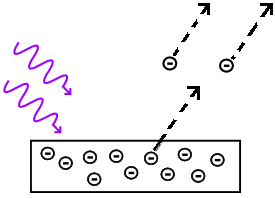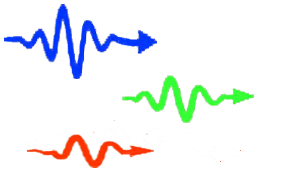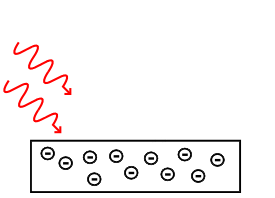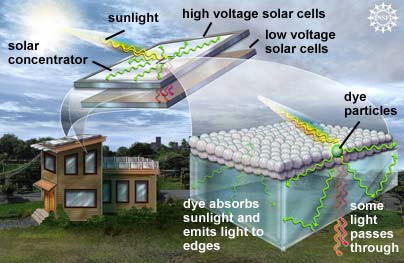From clues to news
New window on solar cells

Better solar
Do you remember the big question at the start of your investigations: Why can't solar cells turn all the sunlight that hits them into electricity?
You now have a lot of the information you need to answer this.
Remember the clues you found during the science trail at Glasgow Science Centre?
Here they are: bright, escapes, colours, infrared, wavelengths.
Let's put these clues together.
Light to electricity
Everything around us is made of atoms. These have tiny, solid parts in the centre, with bigger clouds of electrons whizzing around them.
The electrons can't easily escape from their atoms. But if something gives them enough energy they will.
Escaped electrons become electricity. This is what we want.
Set them free

Light has energy. If we shine light on certain materials the energy in the light sets electrons free and produces electricity.
That's what happens in a solar cell.
The brighter the light on the solar cell, the better it works - the more efficient it is. Remember efficiency? It's just the energy that comes out divided by the energy that goes in.
The latest news story is about scientists inventing a new way to gather lots of light in one place. This makes it really bright when it shines on the solar cells.
Bright and energetic

But it's not all about brightness. Wavelength is important too.
Why?
Well light energy comes in packets. And the energy in a packet depends on the wavelength.
Long wavelengths have small packets of energy. Short wavelengths have larger packets.
Blue light has shorter wavelengths than red light. So blue light packets have more energy than red light packets.
Ultra-violet has shorter wavelengths than blue light. So ultra-violet packets have more energy than blue light packets.
That's why staying out in the sun too long is bad for your skin. Ultra-violet in sunlight has so much energy in its packets that it damages your skin.
This one's too small

So what have wavelength and packets got to do with our big puzzle about the efficiency of solar cells?
It's like this. A certain amount of energy is needed to set an electron free. The exact amount depends on the material.
If a light packet with exactly that energy hits a solar cell, all its energy becomes electricity. If the whole of sunlight had exactly the right energy our solar cell would work perfectly.
But the Rainbow and Hot Spots at Glasgow Science Centre show that sunlight has lots of different wavelengths in it.
So packets of energy in sunlight come in all different sizes.
Some will be exactly right for setting an electron free. But not many.
What happens when packets that aren't exactly right hit a solar cell?
Well, when they're too small the answer is easy.
Nothing.
Lots of them
You can't set an electron half-free. So if a packet has too little energy it won't do anything useful.
If the material is see-through like a solar cell, the small packet zips straight through.
It doesn't matter how bright the light is. Brightness just means more packets. If one packet hasn't enough energy to do the job, lots of packets won't get it done either.
Electrons can't grab packets of energy until they have enough saved up. It's all or nothing.
If it's nothing with one packet it's still nothing with a hundred.
So solar cells can't use all the energy in sunlight that comes in packets too small to set an electron free.
This one's too big

But small packets are not the only problem.
Big packets of energy must be better because each one can set an electron free. Right?
Yeah, but .....
The trouble with a big packet is that it's all or nothing with light packets too. So the electron gets all the energy in the light packet. Which is more than it needs.
The electron zips out of the atom and starts charging around. It bangs into things. It heats them up.
Heat is wasted energy.
This one's just right
So if the light packet is too small we get no electricity.
If the light packet's too big we get electricity. But we also get energy wasted as heat.
What we really need is sunlight with only one wavelength. Which wavelength?
Well that depends on the material the solar cell is made from.
The cheapest solar cells and the easiest to make are of crystalline silicon.
The goldilocks wavelength - the one that's just right - for crystalline silicon is 1125 nanometres (a nanometre is a thousand-millionth of a metre.)

That's an infra-red wavelength. But only just.
So all the visible light and ultra-violet that hits a solar cell made of crystalline silicon has too much energy in its packets. That means lots of visible and ultra-violet energy in sunlight is wasted as heat in the solar cell.
What about the infra-red? Well most of the infra-red in sunlight has wavelengths longer than 1125 nanometres. So most infra-red packets don't have enough energy to free an electron.
They shoot through the cell and are lost.
Make a better solar cell

How?
Why not take a look at the news story now, to see how the MIT scientists have been tackling the problem.
As you're reading, have a think about these questions:
Have the scientists been working mainly on brightness or on wavelength? Why did they decide to do that?
Another question. You might have noticed we haven't used one clue from the science trail yet.
See if you can find the part of the news story where light reflects inside glass and can't easily escape.
And one final question before you go - we did say scientists ask questions:
Imagine you are one of the scientists on the MIT team.
What would you like to do next to try to make a better solar cell?

